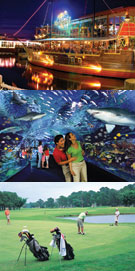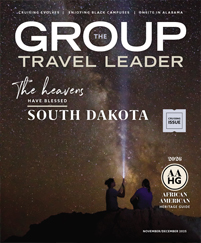The violent image of two horses engaged in a fierce battle sharply contrasts with bright yellow waves of daffodils that line the entrance to Brookgreen Gardens near Myrtle Beach, S.C. The Fighting Stallions sculpture and surrounding flowers heralded the way into the country’s largest garden of American figurative sculpture.
“Brookgreen Gardens is the legacy of two inspired people, Anna and Archer Huntington, who left their estate to you and me,” said Charlie Ferguson, a volunteer guide at the gardens. “Diana of the Chase is Anna’s most famous sculpture. Diana is the goddess of the moonlight, so that’s the theme surrounding the sculpture, with a round lake for the moon and white flowers encircling the lake for the stars.”
Gods, goddesses, myths and legends in stone and metal stand amid the gardens’ color, with little evidence of the rows of rice that once covered the area. This serene retreat between Myrtle Beach and Pawleys Island adds another way to relax in the Myrtle Beach area to the 60 miles of beaches, 104 golf courses, and abundant shopping and entertainment opportunities.
Believe-it-or-not aquarium
I looked up as a dark shadow fell over me to see a large tiger shark directly overhead slicing through the water with sharp teeth showing. Ripley’s Aquarium’s 330-foot-long glass tunnel and moving walkway carried me under a 750,000-gallon tank called Dangerous Reef at my first stop on a tour of the beach town.
Dangerous Reef simulates the experience of scuba diving, with the water’s ripples casting rolling shadows across the floor. A nurse shark playfully scratched his back on the sand and colorful schools of fish moved with me along the walkway. With an ancient-looking sea turtle and a variety of marine life gliding around a replicated sunken ship, I felt straight out of a scene from Finding Nemo.
 |
| 300 acres of flower-bedecked sculptures at Brrokgreen Gardens, top; rockin’ shows at Freestyle Music Park, middle; and sea life up close and personal at Ripley’s Aquarium, bottom. Top photo by Eliza Tychonievich, middle courtesy Freestyle Music Park, bottom courtesy Myrtle Beach Area CVB |
Other underwater exhibits highlight various ecosystems around the world, such as the freshwater Rio Amazon exhibit with piranhas, the Living Gallery with a Pacific giant octopus and the Schooling Fish Tank with fish native to Myrtle Beach’s coastal waters. Beside the Ray Bay touch pool, I viewed barracudas and sawfish swimming in the Dangerous Reef, this time from above.
“Our newest exhibit is our Babies Aquarium,” said Jessica Mula, marketing assistant for Ripley’s Aquarium. “It shows different creatures incubated, such as sharks. Chicks also hatch here daily.”
The aquarium is part of one of the most popular destinations in Myrtle Beach: Broadway at the Beach. The 350-acre entertainment complex boasts more than 100 specialty shops, 20 restaurants and a 400-seat IMAX 3D Theatre, which caused me to lean back from Dinosaurs Alive‘s convincing depictions of Giganotosauruses reaching out of the screen for a meal.
Broadway at the Beach’s shopping center along a lake features a wide range of products, including coastal decorative gifts, fudge and outfits for pets.
Next, I toured Grand Dunes’ 2,200-acre four-star community, which holds nine 18-hole championship golf courses, including the Pine Lakes Country Club. Designed after Scottish golf courses, Pine Lakes Country Club became Myrtle Beach’s first golf resort in 1927 and reopened in March after a 20-month restoration. From the veranda of the 1927 antebellum clubhouse, the rolling hills of the course stretched before me.
“When you go into Pine Lakes Country Club, you feel like you’ve stepped back into Gone With the Wind,” said Michelle Sutton, vice president of sales and marketing for Burroughs and Chapin Co., which owns Pine Lakes. “It’s Southern beauty at its best.”
The clubhouse offers beverages and dining options for golfers, and a glimpse into the clubhouse’s past at the History Hall and Myrtle Beach Golf Hall of Fame. The hall of fame honors past golfers and others who aided in creating Myrtle Beach’s nickname, “the golf capital of the world.”
Cheeseburger in paradise
It’s not every day you get to see a giant tequila bottle descend from a simulated hurricane cloud on the ceiling to make a margarita. But that is part of the kooky fun of the Jimmy Buffet-themed Margaritaville. The restaurant serves seafood and other specialties, such as Cheeseburger in Paradise, inside a decorative tropical oasis.
Afterward, I watched with wide eyes as costumed acrobats soared through the air, juggled large objects and balanced candles on their arms, legs and heads while contorting into different shapes at Le Grande Cirque. The show’s crazy stunts make what seems impossible look easy at the 2,638-seat Palace Theatre.
Wild outfits and spectacular lighting effects make the creative flips and balancing tricks that much more impressive. Both the Palace Theatre and Margaritaville are connected to Broadway on the Beach’s diverse complex.
The next day, I wandered through the winding trails of Brookgreen Gardens. A guided walking tour helped me notice the deliberate themes of each section.
 |
| Group-friendly restaurants such as Margaritaville Myrtle Beach, top; a 330-foot glass tunnel at Ripley’s Aquarium, middle; and 104 golf courses, bottom. Courtesy Myrtle Beach Area CVB |
“The Palmetto Garden has a masculine theme, with Sabal palmetto trees and the Samson and the Lion statue,” said Ferguson. “And I can’t think of a more ‘guy’ thing than a nut trying to wrestle a lion.”
The whimsical Fountains of Muses display, powerful Pegasus display and fanciful Peace Garden Room for Children surround different sculptures with similarly themed plant life. Ferguson paused at each area to explain the sculptures and relate the history of the gardens from its roots as a rice plantation to its current gardening practices.
At the gardens’ Lowcountry Zoo, enclosed native animal habitats allowed me to see Myrtle Beach’s wilder side, with Marsh Tacky horses, an alligator, a red fox and two playful otters. A trail connecting the zoo to the gardens presents more of the history of the former plantation, with archaeological sites, interpretive signs of slave quarters, a smokehouse and an overseer’s house.
I visited a new attraction, called the Freestyle Music Park, before it opened in May. The amusement park originally opened last year as Hard Rock Park but filed for bankruptcy after its first season. New owners reopened the 55-acre park as a more family-oriented venue with a wider range of music and attractions.
The new Kids in America themed area features 11 attractions targeting the younger crowd, with rides called Cuckoo-Ka-ChooChoo and Doo Wop Dune Buggies. These and other rides are matched with classic rock tunes.
The eye-catching Time Machine roller coaster reaches speeds of 65 miles per hour; the accompanying classic audio tracks from the 1960s to the present make the ride even more of a thrill.
“We want to be part of the Myrtle Beach destination in the long term,” said John Stine, director of sales and marketing for the park. “We want to attract people who haven’t heard of it yet. We see great opportunity to host a lot of groups, so we are ensuring that we have those facilities.”
Live stage shows also run regularly in the park alongside about 50 attractions, such as roller coasters, restaurants, cafes and retail stores.
That evening, I dined on fresh local seafood at Waterscapes in Marina Inn. The elegant 2,200-acre resort offers guests access to two championship golf courses, a 130-slip marina and decor adapted from the Mediterranean, Asia and Polynesia.
Three times a week the chef of Waterscapes meets with local fishermen coming in with their catches of the day to ensure the freshest seafood available. My four-course meal consisted of samplings of various types of seafood stylishly prepared, such as sauteed queen triggerfish, roasted hog snapper and wood-grilled broomtail grouper.
The meal reminded me that there is more to the beach than scenery and entertainment. There is also amazing seafood that landlocked cities just
can’t beat.









